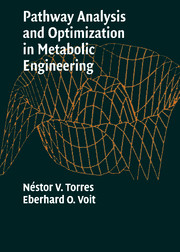Book contents
- Frontmatter
- Contents
- Preface
- 1 Target: A Useful Model
- 2 Methods of Biochemical Systems Theory
- 3 A Model of Citric Acid Production in the Mold Aspergillus niger
- 4 Optimization Methods
- 5 Optimization of Biochemical Systems
- 6 Optimization of Citric Acid Production in Aspergillus niger
- 7 Maximization of Ethanol Production in Saccharomyces cerevisiae
- 8 Conclusions
- Author Index
- Subject Index
- Plate section
- References
8 - Conclusions
Published online by Cambridge University Press: 28 July 2009
- Frontmatter
- Contents
- Preface
- 1 Target: A Useful Model
- 2 Methods of Biochemical Systems Theory
- 3 A Model of Citric Acid Production in the Mold Aspergillus niger
- 4 Optimization Methods
- 5 Optimization of Biochemical Systems
- 6 Optimization of Citric Acid Production in Aspergillus niger
- 7 Maximization of Ethanol Production in Saccharomyces cerevisiae
- 8 Conclusions
- Author Index
- Subject Index
- Plate section
- References
Summary
The two pathways we discussed in the previous chapters, namely citric acid accumulation in the mold A. niger and ethanol production in yeast, are good and at the same time not-so-good examples. They are good for the illustration of the proposed methods, because they are well known and relevant. Many kinetic features of the enzymatic and transport steps are readily available in the literature, and the glycolytic and citric acid pathways themselves, as well as diverging side branches, are well known in the biochemical community. Furthermore, both pathways are of undoubted industrial relevance, so that every predicted improvement in yield could potentially translate into biotechnological strategies of interest.
The examples are not ideal for a very closely related reason. Because of the strong industrial interest in ethanol and citric acid, uncounted scientists have been charged over the years with finding ways to increase their yield. As a consequence, it seems that “simple” means of improvement, consisting of alterations in one or two enzymes or transport steps, have already been found by experimental methods, such as random mutagenesis and selection. Consistent with the infeasibility of simple solutions, the predictions made from our mathematical optimizations require targeted and specific changes in several steps simultaneously. This translates directly into considerable experimental effort, which so far has precluded implementation in the laboratory, against which we could compare our results.
The conjecture that singular changes in well-studied systems are often ineffectual is supported by experimental evidence that has been surprising and disappointing at times.
- Type
- Chapter
- Information
- Pathway Analysis and Optimization in Metabolic Engineering , pp. 273 - 290Publisher: Cambridge University PressPrint publication year: 2002



